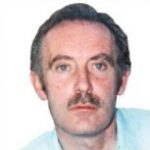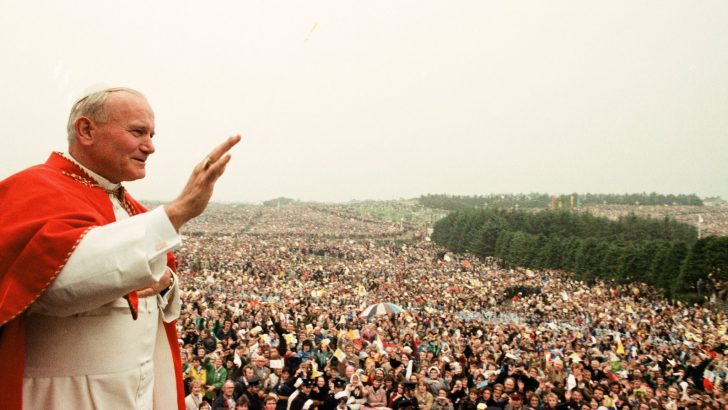Pope John Paul II in Ireland: A Plea for Peace (12A)
Did the 1979 visit of Pope John Paul II to our shores eventually impact on the Good Friday Agreement that saw “the force of argument”, as this fascinating documentary puts it, replacing “the argument of force”? Or as Seamus Heaney said, helped “hope and history rhyme”?
It frames his visit in the context of 700 years under suppression by British rule and the manner in which we crawled out of that suppression through revolution, dialogue and a mixture of both.
Taking us back to the invasion of Henry II, the Reformation, the Ulster Plantation, the Penal Laws, the Battle of Orange, the failed coup of 1798 and the Act of Union that followed a few years afterwards, the film becomes a kind mini-history of Ireland’s violent past set against the backdrop of his trip here.
The Famine is also mentioned, and the decimation of our country’s population that followed it. It was many years later that we had the Home Rule Bill of 1912, but this wasn’t fully implemented because of the outbreak of World War I, which led indirectly to the Uprising of 1916, the Civil War that followed it, and our eventual independence.
Escalation
Tensions simmered in the fractured six counties during the following decades, as everyone is all too painfully aware. They exploded in 1969 with many outbreaks of violence, followed by the internment of 1971 brought in by Brian Faulkner, a disastrous move that only resulted in its escalation.
Pope John Paul II knew of many if not all of these events when he made his landmark visit here. The film makes the point that even though he was an avatar for change and a profoundly charismatic speaker, IRA violence continued after he left Ireland, in Britain with atrocities in places like Hyde Park, and here with murders, punishment shootings and hunger strikes in the Maze prison. (He was even a victim of violence himself when he became the victim of an attempted assassination, something the film almost glosses over.)
There was never, of course, going to be a quick fix to a problem that had gone on so long. As Terence O’Neill once stated, Northern Ireland was somewhere that was “born in pain”.
There was no magic bullet that could erase that pain overnight. Too many people had died on both sides; too many jobs had been taken from Catholics by Protrestants in war-torn Belfast, too many people dragged out of their beds in the middle of the night in pogrom-like raids to be interrogated – or murdered – on spurious pretexts.
Neither were the British noted for being a nation that ceded control of their colonies easily. Brian Keenan wrote in the last line of his brilliant memoir An Evil Cradling, “freedom comes slowly at first”. Everything reached a head on Bloody Sunday, as the film makes clear. It posits this as one of the most obvious precursors of the Good Friday Agreement but the Omagh bombing should have been mentioned as well.
It was here, it should be remembered, where the IRA killed many Catholics as well as Protestants. (Statistically, the film points out, the IRA killed more Catholics than the British Army and the Northern Ireland Police Service combined over the years, something I hadn’t been aware of.)
No matter how eloquent the Pope was, actions always speak louder than words. The British war poet Robert Graves famously said: “Not one poem of mine saved a Jew from Auschwitz.” The bullet was never going to be replaced with the ballot box overnight.
It was all of 20 years after his visit that the Good Friday Agreement was signed. By that time, both the British government and the IRA knew they’d reached an impasse. Like America in Vietnam a few decades before, they realized they were fighting an unwinnable war.
Whether we like it or not, peace sometimes comes about not as a result of the rhetoric of heads of state – or Church – but because of good old-fashioned common sense. Or as Winston Churchill once put it: “Events, dear boy, events.”
Having said that, the Pope’s inspirational addresses in Drogheda, Clonmacnoise, Galway and Limerick were hugely influential for the fact that it came about. The singer/politician Dana describes these addresses as being “the bedrock” for it.
Michael Kelly, who’s also interviewed in the film, sees the Limerick address as being one of the neglected aspects of the Pope’s visit, a prophetic one that seemed to fly in the face of the optimism he showed elsewhere, suggesting Ireland was at a crossroads not only politically but spiritually as well and that dark clouds were on the horizon.
More positively, Michael speaks of his parents telling him time and again about the convoys of cars streaming across the border to see the Pope in Drogheda. Nearly three million people saw him during his visit here in all, almost half the population of the country.
*****
He was a relatively young man, unlike many previous Popes, which seemed to suggest almost a gerontocracy at work in the Vatican. He was also very interested in immersing himself in Irish culture – and cuisine. For his in-flight meal he had an Irish fry and three cups of coffee. Details like this were delightedly picked up by the press. They humanised him, making him more into a person than a patriarch.
He even said disarmingly to interviewers, “I am not an interesting man.”
When he came to speak about the North, such humanness became even more striking. “On my knees I beg you,” he said, “to turn away from the path of violence.” When before had we heard such passion – or humility – emanating from the mouth of a pontiff? It would have been difficult to imagine a man of the austerity of, say, Pope Paul VI, speaking like this.
Pope John Paul II also knew how to work a crowd. He had a warmth about him; he had the ability to listen. His English was good, if broken. His bright eyes seemed like the windows of his soul.
That was why, when he told the congregation at Galway during his Mass there, “young people of Ireland, I love you” – a phrase that would be remembered more than any other one he uttered during his time here – he received an 11-minute standing ovation for it.
It was said, as Michael Kelly notes, at a time when people weren’t in the habit of evincing such personal feelings, least of all popes. Most of us were aware our parents loved us in 1979 but they didn’t usually say so, unlike today when ‘love you’ seems almost as common an expression as ‘hello’. It had a big impact because nobody was expecting it.
Many people who will be familiar to The Irish Catholic readers feature in the documentary: Nuala O’Loan, Mary Kenny, Martin Mansergh and Breda O’Brien. Footage of the visit is interspersed with their observations on it, alongside observations by people like Cardinal O’Fiaich, Fr Alec Reid, Fr Michael Neary, Cardinal Cahal Daly, Lord David Alton, Rev. Harold Good, Jeffrey Donaldson, historian Diarmaid Ferriter, author/journalist Tim Pat Coogan and so on.
We also see people like Bertie Ahern, someone who, whatever we may say about his mismanagement of our economy preceding the recession, was always brilliant at brokering deals. We see Albert Reynolds, Gerry Adams and John Hume, who’s unfortunately in poor health now. And Tony Blair, a politician I highly admired at this time. Sadly, power went to his head afterwards, as he showed when he travelled on the coat-tails of George Bush during that man’s over-zealous militaristic endeavours in subsequent years, resulting in the upsurge of terrorism that has made the world such a dangerous place today.
It also shows David Trimble, someone who’s almost forgotten today despite risking the wrath of his own party by offering compromises to the IRA that were unprecedented by a man from his Orange background. He failed in the end but it wasn’t due to lack of commitment. The time was simply against him. (Once again it was a case of “events, dear boy, events”.)
*****
A Plea for Peace isn’t an unduly lengthy film at 69 minutes but under the direction of Marc Boudignon and David Naglieri, and the narration of Jim Caviezel (who played Jesus in The Passion of the Christ in 2004), it makes every moment count.
As well as the above figures it deals with other ones as well. Fr Paul Clayton-Lea for instance, who was inspired to become a priest by the “groundswell” of positive thinking the Pope engendered in him. We also hear the story of Richard Moore, a man who was blinded by a rubber bullet at the age of 10 but who was inspired by the Pope to forgive the person responsible.
And then there’s Shane O’Doherty, a former IRA man who was sentenced to life imprisonment for a letter-bombing campaign he conducted in England but who turned to God in prison, largely as a result of Pope John Paul II’s influence on him. His conversion was greeted with scepticism by some but he sounds genuine in the film.
At the centre of it all, needless to say, is the man formerly known as Karol Wojtyla. “He seemed to have a power beyond a human one,” Ronan Mullen opines, “a power that blessed us all”.
He was also someone well qualified to speak on political suppression, having experienced it in his own country when the jackboot of Nazism plundered Poland so viciously during his youth. Seamus Mallon says he reminded him of what he thought St Peter would have been like if he’d been born in the 20th Century.
Northern Ireland was, in a way, his second Poland. He saw kindred souls there and wanted to reach out to them. His condemnation of violence helped disabuse people of the oft-held belief that the Church here was within the grip of the IRA, that they, as the film notes, “sang from the same hymn sheet”.


 Aubrey Malone
Aubrey Malone
